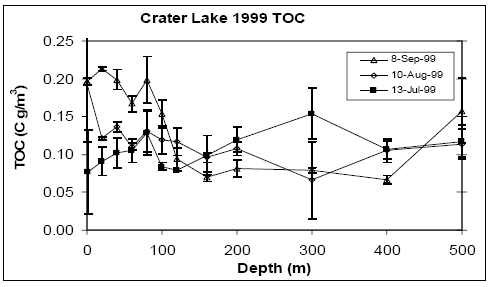Another bio-optical signal, chlorophyll-a fluorescence (Fchl), has been recorded in Crater Lake depth profiles since 1999 and provides a proxy for UV attenuation consistent with the dominant role of phytoplankton absorption and scattering. Figure 11A shows Kd,380 and Fchl for 20 August 2001 and the correspondence between the two signals is apparent. However at depths above about 80 m there are subtle differences between the two signals and for this upper part of the photic zone Kd,380 more closely resembles the cp660 signal (also plotted in Figure 11A). A simple empirical model estimates Kd,380 (heavy curve in Figure 11A) from cp660 and Fchl (?g/L from fluorescence) by combining the two bio-optical signals: Kd,380=0.40*FChl+0.36*cp660. The Fchl and cp660 signals are also combined in a ratio (Fchl/cp660) in Figure 11B to show changes with depth and season for 2001 as a proxy for chlorophyll-a:carbon ratios. Figure 11B shows a distinct peak near the surface on 14 August (20–40 m) and a smaller surface peak on 20 August (40–60 m). Ratios on all dates increased with depth to a maximum corresponding to the DCM. Below the DCM the pattern varied with season, generally declining during the course of the summer.
Figure 8A. Crater Lake particulate organic carbon (POC, C g m-3) versus depth, 1999. POC was derived from 2 m binned cp660 data (SeaTech transmissometer). Calculation: POC = (cp660+0.024-X)/0.032)/83.3 (proxy equation from Boss et al., this issue, but X was adjusted on each date to match POC over 300–500 m for all dates). Photic zone particulate carbon appears to increase over the course of the summer.
Figure 8B. Crater Lake Total Organic Carbon (TOC) versus depth, 1999. TOC (carbon g m-3) in whole water samples was determined from three analytical replicates with a Shimadzu TOC-5000 (error bars are +/- S.E.).



